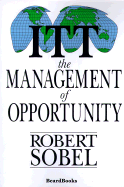|
|
|
|
||||||

|
ITT: The Management of Opportunity
By Robert Sobel 2000/03 - Beard Books 1893122441 - Paperback - Reprint - 430 pp. US$34.95 Robert Sobel portrays this giant conglomerate "as an organizing principle and a force more than anything else," but one lacking cohesion. Publisher Comments
ITT is the history of what became the world's largest conglomerate. Robert Sobel traces the rise of the company through the leadership of the first three CEOs who shaped the giant conglomerate by their unique entrepreneurial skills, vision, and financial machinations. Written from the inside without being sponsored or subsidized by ITT, the book presents a candid view of the effects on ITT of the vicissitudes of the Depression, ITT's suspected financial dealings with the Germans during World War II, and the challenges posed by the electronic revolution. Review by Gail Owens Hoelscher We all know how it ends, but whew, what a ride! An enterprising man envisions a world-wide telecommunications company and guides it vigilantly through hard times; his successor radically changes course, buying up hundreds of unrelated companies; economic conditions and the national mood change; the conglomerate sags under its own weight; the next CEO retrenches and then wards off hostile takeovers; and the company is sold. This account of the ITT story was published in 1982, 15 years before the end. The author was given complete access to records and files, and employees were instructed to be candid and forthcoming. The result is evenhanded, thorough, and well written, and provides solid historical background for and thoughtful analysis of the various events. ITT founder Sosthenes Behn was born in the Caribbean and educated in Europe. He and his brother began their hoped-for "International System" of worldwide interconnected telephone lines in 1920 by acquiring two small telephone companies in Puerto Rico and Cuba. Sobel recounts ITT's forays into Spain, Mexico, and South America; attempts to purchase RCA Communications in the late 1920s; acquisitions in France and Germany; and near insolvency during the Depression. When Beim turned to the U.S. market, he felt inadequate to the task and stepped down from ITT. Eventually, his successor was found in Harold Geneen, an outsider from Raytheon. Under Geneen, ITT quickly became one of the fastest growing corporations in the U.S. ITT once acquired some 20 unrelated companies in one month. Sales grew from $930 million in 1961 to $8 billion in 1970. ITT's descent began in 1966, when it tried to acquire ABC. National sentiment against conglomerates had become vitriolic and this merger became its target. As Sobel put it, "Perhaps not since the end of the war had so many large groups arrayed themselves against a single corporation involved in a merger." In the end, despite FCC approval of the merger in two separate rulings, ITT and ABC yielded to the Department of Justice, media censure, and public opinion, and abandoned their merger plans. Next came a variety of allegations against ITT, some well substantiated and all well publicized: funding Salvador Allende's opponents in Chile's 1970 presidential elections; peddling of influence in the Nixon White House to rid the DOJ of trustbusters; and exchange of campaign donations for use of a Sheraton hotel as the 1972 Republican National Convention headquarters in San Diego. All the while, ITT's poor handling of several antitrust cases were also making headlines. And then came recession in 1973. Geneen had difficulty adjusting to ITT's new business climate. His theory that growth could serve as business strategy had been disproved. ITT's stock fell from 60 in early 1973 to 12 in late 1974. Under pressure from ITT's board, Geneen stepped down in 1977, but masterminded the dismissal of his successor, Lyman Hamilton, and installation of Rand Araskog in 1978. When the book ends in 1982, Araskog had begun a plan of coherent divesting and reorganizing the company into more manageable segments, prelude to the dismantling that was to take place in the hostile-takeover wars. ITT: The Management of Opportunity, June 19, 2000 Robert Sobel provides us with a fascinating look at one of the world's largest conglomerates, ITT -- the former owner of everything from a Financial Services Group to the famous ITT Sheraton Collection of Hotels. Beginning with the company's foray into telecommunications in the early 1920's right up to the company's mammoth structure in the '70s and '80s, the reader is provided with an intriguing history of this famous company... one which acquired some twenty unrelated companies in one month! This book is a must-have for the business-history buff. Robert Nathen Sobel was a professor of business history at Hofstra University for more than forty years and held a Ph.D. from New York University. He is author of more than two dozen books on American economic and business history, including Herbert Hoover and the Onset of the Great Depression and Coolidge: An American Enigma. Besides producing books, articles, book reviews, scripts for television and audiotapes, he was a weekly columnist for Newsday from 1972 to 1988. In 1998, Sobel was the recipient of the second Special Achievement Sidewise Award for Alternate History for this book, which was republished in 1998.At the time of his death he was a contributing editor to Barron's magazine He died Wednesday, June 2, 1999 of brain cancer. Professor Sobel was 68. Sobel is a highly esteemed business historian. Sobel's purpose in any book he wrote was to help his reader learn from them. Enigma. Besides producing books, articles, book reviews, scripts for television and audiotapes, he was a weekly columnist for Newsday from 1972 to 1988. In 1998, Sobel was the recipient of the second Special Achievement Sidewise Award for Alternate History for this book, which was republished in 1998.At the time of his death he was a contributing editor to Barron's magazine He died Wednesday, June 2, 1999 of brain cancer. Professor Sobel was 68. Sobel is a highly esteemed business historian. Sobel's purpose in any book he wrote was to help his reader learn from them.
|
|
|
|
home
| about us
| contact us
| related
sites |